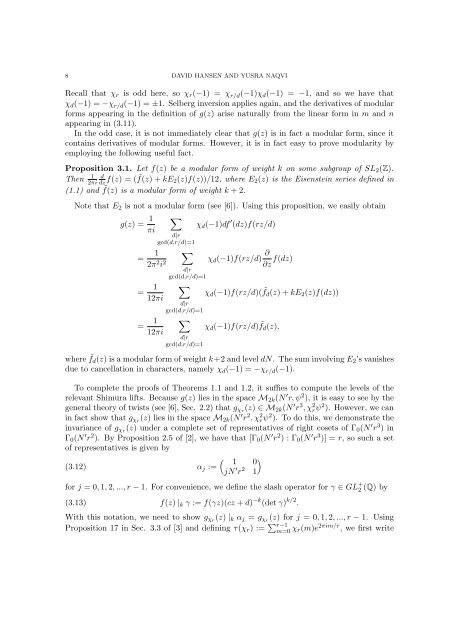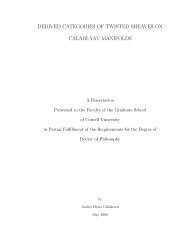Shimura lifts of half-integral weight modular forms - Department of ...
Shimura lifts of half-integral weight modular forms - Department of ...
Shimura lifts of half-integral weight modular forms - Department of ...
You also want an ePaper? Increase the reach of your titles
YUMPU automatically turns print PDFs into web optimized ePapers that Google loves.
8 DAVID HANSEN AND YUSRA NAQVI<br />
Recall that χr is odd here, so χr(−1) = χ r/d(−1)χd(−1) = −1, and so we have that<br />
χd(−1) = −χ r/d(−1) = ±1. Selberg inversion applies again, and the derivatives <strong>of</strong> <strong>modular</strong><br />
<strong>forms</strong> appearing in the definition <strong>of</strong> g(z) arise naturally from the linear form in m and n<br />
appearing in (3.11).<br />
In the odd case, it is not immediately clear that g(z) is in fact a <strong>modular</strong> form, since it<br />
contains derivatives <strong>of</strong> <strong>modular</strong> <strong>forms</strong>. However, it is in fact easy to prove <strong>modular</strong>ity by<br />
employing the following useful fact.<br />
Proposition 3.1. Let f(z) be a <strong>modular</strong> form <strong>of</strong> <strong>weight</strong> k on some subgroup <strong>of</strong> SL2(Z).<br />
Then 1 d<br />
2πi dz f(z) = ( ˜ f(z) + kE2(z)f(z))/12, where E2(z) is the Eisenstein series defined in<br />
(1.1) and ˜ f(z) is a <strong>modular</strong> form <strong>of</strong> <strong>weight</strong> k + 2.<br />
Note that E2 is not a <strong>modular</strong> form (see [6]). Using this proposition, we easily obtain<br />
g(z) = 1<br />
πi<br />
<br />
χd(−1)df ′ (dz)f(rz/d)<br />
= 1<br />
2π 2 i 2<br />
= 1<br />
12πi<br />
= 1<br />
12πi<br />
d|r<br />
gcd(d,r/d)=1<br />
<br />
d|r<br />
gcd(d,r/d)=1<br />
<br />
d|r<br />
gcd(d,r/d)=1<br />
<br />
d|r<br />
gcd(d,r/d)=1<br />
χd(−1)f(rz/d) ∂<br />
∂z f(dz)<br />
χd(−1)f(rz/d)( ˜ fd(z) + kE2(z)f(dz))<br />
χd(−1)f(rz/d) ˜ fd(z),<br />
where ˜ fd(z) is a <strong>modular</strong> form <strong>of</strong> <strong>weight</strong> k+2 and level dN. The sum involving E2’s vanishes<br />
due to cancellation in characters, namely χd(−1) = −χ r/d(−1).<br />
To complete the pro<strong>of</strong>s <strong>of</strong> Theorems 1.1 and 1.2, it suffies to compute the levels <strong>of</strong> the<br />
relevant <strong>Shimura</strong> <strong>lifts</strong>. Because g(z) lies in the space M2k(N ′ r, ψ 2 ), it is easy to see by the<br />
general theory <strong>of</strong> twists (see [6], Sec. 2.2) that gχr(z) ∈ M2k(N ′ r 3 , χ 2 rψ 2 ). However, we can<br />
in fact show that gχr(z) lies in the space M2k(N ′ r 2 , χ 2 rψ 2 ). To do this, we demonstrate the<br />
invariance <strong>of</strong> gχr(z) under a complete set <strong>of</strong> representatives <strong>of</strong> right cosets <strong>of</strong> Γ0(N ′ r 3 ) in<br />
Γ0(N ′ r 2 ). By Proposition 2.5 <strong>of</strong> [2], we have that [Γ0(N ′ r 2 ) : Γ0(N ′ r 3 )] = r, so such a set<br />
<strong>of</strong> representatives is given by<br />
(3.12) αj :=<br />
<br />
1 0<br />
jN ′ r2 <br />
1<br />
for j = 0, 1, 2, ..., r − 1. For convenience, we define the slash operator for γ ∈ GL + 2 (Q) by<br />
(3.13) f(z) |k γ := f(γz)(cz + d) −k (det γ) k/2 .<br />
With this notation, we need to show gχr(z) |k αj = gχr(z) for j = 0, 1, 2, ..., r − 1. Using<br />
Proposition 17 in Sec. 3.3 <strong>of</strong> [3] and defining τ(χr) := r−1<br />
m=0 χr(m)e 2πim/r , we first write
















